Webpages tagged with «Climate change»

This project explores how climate change and other long-term environmental changes can influence the transport, uptake and food web transfer of mercury in boreal lakes.

Surface waters in Scotland, as well as in southern Norway and southern Sweden have experienced a significant increase in NOM-concentrations and fluctuations over the last decades, likely due to the combined effects of climate variation and reduced acid rain.
NOM concentration levels and physiochemical properties vary significantly in space and time. Especially the seasonal fluctuations are site specific and therefore unique to any raw water source.
Surface waters are commonly used as raw water sources by waterworks for tap-water production in these countries. NOM in the water affect colour, taste and odour. Increasing concentrations of NOM, thus, causes increased demand for coagulant and disinfectant doses. NOM influences, furthermore, the stability and thereby the removal of inorganic particles and pathogens and increase the mobility of micro-pollutants. It fouls membranes, block filtration pores and compete for adsorption sites. In the water distribution networks, NOM influences on corrosion and leads to regrowth and biofilm formation during distribution, including house installations (e.g. problems with biofilm-amoebae-Legionella).
The increasing amount and variability of NOM concentrations and characteristics, thus, represents severe challenges for process control in water treatment and distribution systems.

Lakes and rivers are the source of drinking water for most people in Norway, Sweden and Finland. Presently, climate change is posing a threat for the quality of drinking water sources. In recent years, concentrations of dissolved organic matter (DOM) in lakes and rivers have increased and associated with this, surface waters have become browner. This poses a major challenge to drinking water providers, as removal of DOM is a key step in drinking water treatment.
Both climate and atmospheric deposition are likely to blame for the brownification of surface waters. Brownification is expected to continue under climate change, but to what extent is unclear. Adaptation measures needed are likely to raise costs of water treatment and require long-term investments. In order to maintain good drinking water quality in the future, municipalities and other stakeholders urgently need science-based projections of raw water quality under climate change as well as information about the possibilities for, and costs of adaptation.